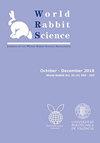环境对雌兔发育及终生繁殖性能的影响
IF 1.3
4区 农林科学
Q3 AGRICULTURE, DAIRY & ANIMAL SCIENCE
引用次数: 0
摘要
不同性质和强度的环境损害,如气温波动,会影响食物的获取、食物的质量和疾病,在任何牲畜系统中都是一个现实。当侮辱发生在生命早期时,这一点更为重要,影响着动物的发育和成年生活。例如,在生态学中,人们普遍认为,高质量的后代对捕食者的反应更强,占据更好的领地,找到更多的配偶,从而寿命更长,更健康。此外,青少年时期遭受饥荒或疾病的成年人寿命较短,后代也较少,这也是公认的事实。为了确定环境是否会影响母兔的发育和终身生殖性能,我们设计了一项结合巢和幼体发育两个因素的实验。通过记录864只雌鸟在哺乳期和青春期(63 ~ 184天)的平均日增重来测量巢的发育,并通过给动物提供高能量对照(C)或富含纤维(F)的饮食来调节身体发育。然而,在研究过程中,864只青春期雌性兔中有191只暴露于兔出血性疾病(RHD)。这种意想不到的环境侮辱被认为是影响母兔繁殖性能的第三个实验因素。与预期相反,快速的哺乳增加会损害生殖寿命,导致雌性一生中产生的新生儿较少。虽然饮食F的雌性比饮食C的雌性多活37天,但这种差异只在它们的青春期被察觉到。此外,RHD暴露与哺乳增重(SG)相互作用。暴露于高SG的雌性成年后产生更多的幼崽,但在没有病毒的情况下,高SG的雌性产生较少的新生幼崽。这些结果为未来繁殖者在筑巢和青春期的管理提供了新的见解。本文章由计算机程序翻译,如有差异,请以英文原文为准。
Influences of environment on the development and lifetime reproductive performance in domestic rabbit females
Environmental insults of different nature and intensity, such as fluctuation in the air temperature, which can affect access to food, its quality and diseases, are a reality in any livestock system. This is much more important when the insults occur in early life, conditioning the development and adult life of animals. In ecology, for instance, it is widely accepted that high quality offspring are more reactive against predators, occupy better territories and find more mates, resulting in longer lives and greater fitness. It is also a given that adults exposed to famine or disease as juveniles have shorter lives and produce fewer offspring. To determine whether the environment influences the development and lifetime reproductive performance of rabbit females, we designed an experiment combining two factors: nest and pubescent development. Nest development was measured by recording the average daily gain of 864 females during suckling and during their pubescent life (63 to 184 d old), and body development was conditioned by providing animals a high-energy control (C) or a fibre-rich (F) diet. However, in the course of the study, 191 of the 864 pubescent females were exposed to rabbit haemorrhagic disease (RHD). This unexpected environmental insult was considered as a third experimental factor influencing the reproductive performance of rabbit females. Contrary to expectation, fast suckling gain impairs reproductive lifespan, resulting in fewer newborn kits produced in a female lifetime. Although females on diet F lived 37 d longer than females on diet C, this difference was only perceived in their pubescent life. In addition, the exposure to RHD interacted with suckling gain (SG). Exposed females with a fast SG produced more kits as adults, but in the absence of the virus, high SG females produced fewer newborn kits. These results open new insights into the management of future breeders during nesting and pubescent life.
求助全文
通过发布文献求助,成功后即可免费获取论文全文。
去求助
来源期刊

World Rabbit Science
农林科学-奶制品与动物科学
CiteScore
1.70
自引率
25.00%
发文量
22
审稿时长
>36 weeks
期刊介绍:
World Rabbit Science is the official journal of the World Rabbit Science Association (WRSA). One of the main objectives of the WRSA is to encourage communication and collaboration among individuals and organisations associated with rabbit production and rabbit science in general. Subject areas include breeding, genetics, production, management, environment, health, nutrition, physiology, reproduction, behaviour, welfare, immunology, molecular biology, metabolism, processing and products.
World Rabbit Science is the only international peer-reviewed journal included in the ISI Thomson list dedicated to publish original research in the field of rabbit science. Papers or reviews of the literature submitted to World Rabbit Science must not have been published previously in an international refereed scientific journal. Previous presentations at a scientific meeting, field day reports or similar documents can be published in World Rabbit Science, but they will be also subjected to the peer-review process.
World Rabbit Science will publish papers of international relevance including original research articles, descriptions of novel techniques, contemporaryreviews and meta-analyses. Short communications will only accepted in special cases where, in the Editor''s judgement, the contents are exceptionally exciting, novel or timely. Proceedings of rabbit scientific meetings and conference reports will be considered for special issues.
World Rabbit Science is published in English four times a year in a single volume. Authors may publish in World Rabbit Science regardless of the membership in the World Rabbit Science Association, even if joining the WRSA is encouraged. Views expressed in papers published in World Rabbit Science represent the opinion of the author(s) and do not necessarily reflect the official policy of the WRSA or the Editor-in-Chief.
 求助内容:
求助内容: 应助结果提醒方式:
应助结果提醒方式:


